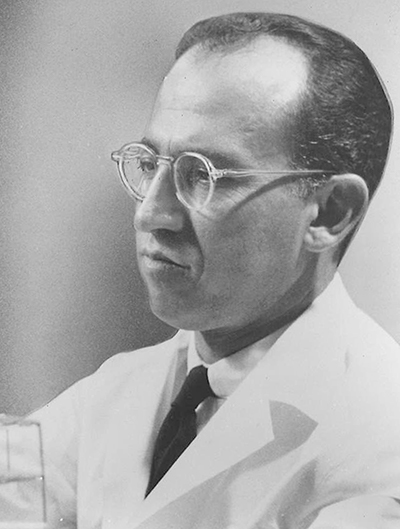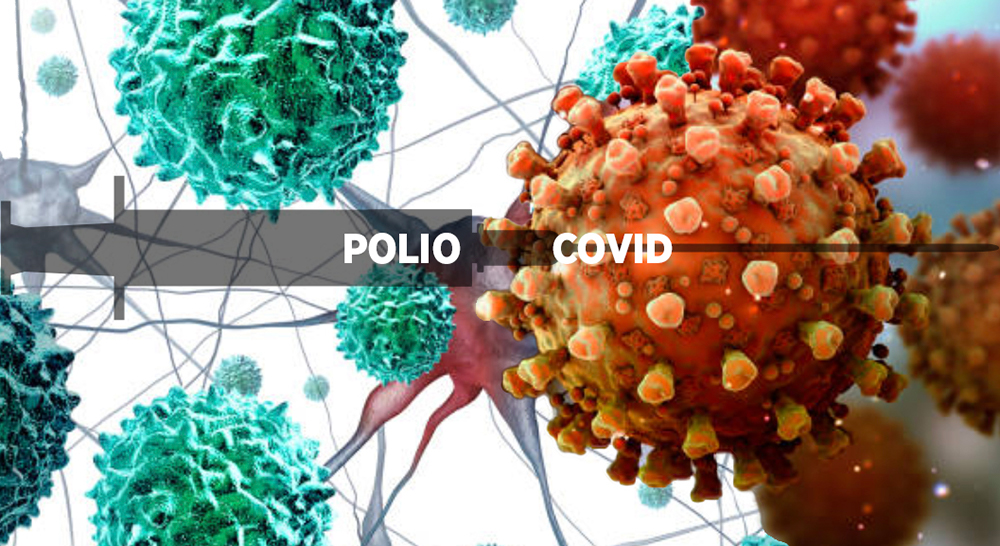

Iron lungs lining spotless hospital wards. Young children on crutches peering out from black-and-white photos. School kids queuing out the door, waiting to receive a vaccine.
Even among those who didn’t live through the polio outbreaks of the early twentieth century, these images resonate. Polio was eventually eradicated from most of the world through a combination of tireless research and the mobilization of a public ready to embrace scientific innovations. But these images remain as haunting depictions of a disease that incapacitated and killed thousands of people worldwide.
First identified in 1908, poliovirus causes poliomyelitis, or polio disease. Though it has impacted humans for centuries, epidemics cropped up in the early twentieth century with increasing frequency in Australia, Europe, and North America. By the 1940s and ‘50s, polio killed nearly half a million people worldwide each year and left many more paralyzed.

Outbreaks were most common in the summer. Affected regions often were subjected to similar measures to what’s being done today during the SARS-CoV-2 pandemic: quarantines for exposed individuals and families, travel restrictions, canceled events, and closed businesses. It’s often reported that polio was the biggest fear of parents in the United States during the 1950s, second only to nuclear war.
Polio changed the way society approached medical philanthropy. US President Franklin D. Roosevelt, a survivor of polio, launched the National Foundation for Infantile Paralysis (now known as the March of Dimes) in 1938 to encourage the public to donate funds for a cure to polio. These funds, as well as enormous research efforts by scientists from across the world, made it possible to develop and distribute what is perhaps the most famous vaccine in the world: the polio vaccine, created by Dr. Jonas Salk and his team at the University of Pittsburg.
Salk’s polio vaccine was the first approved in the US, but it was not the only one created. An oral vaccine developed by Dr. Albert Sabin later became the most predominantly used polio vaccine in the US.
Similarities between yesterday’s polio epidemics and today’s coronavirus pandemic can be observed in the lived experiences of survivors.

“I was a young boy at that time, and while I lived in a small farming community, my parents were very wise and would not allow me to go to large gatherings,” says Dr. Janver Krehbiel, professor emeritus of the MSU College of Veterinary Medicine.
Between then and now, Krehbiel notes that—despite the understood necessity of precautions taken to protect community safety and health—personal disappointments were and are prevalent.
“I could not attend movies, had limited involvement with church activities, and absolutely could not attend the local Kansas Largest Night Rodeo,” he says. “This was a big deal because I could not ride my horse in the Grand Parade. I have since gotten over these disappointments, but what we are doing today is very similar to what happened in the small town of Pretty Prairie, Kansas some 70-plus years ago.”
Dr. George Eyster, retired professor of Cardiology at the College, recalls not being able to enjoy childhood activities like swimming at the community swimming pools. “I also gave a bunch of dimes to the March.”
The campaign to vaccinate children in the United States was an enormous undertaking. Approximately two million kids were involved in the initial tests of Salk’s vaccine. Once the vaccine was proven effective, massive programs were launched to bring the shot, and eventually the oral vaccine, to the public in the form of large events that families would attend to be vaccinated.

Photo citations in order of appearance (from top to bottom): Hospital Ward 1948, March of Dimes Collection, 00226, Michigan State University Archives & Historical Collections, East Lansing, Michigan. Exhibit at Ingham County Fair 1952, March of Dimes Collection, 00226, Michigan State University Archives & Historical Collections, East Lansing, Michigan. Jonas Salk, March of Dimes Collection, 00226, Michigan State University Archives & Historical Collections, East Lansing, Michigan. Hospital Ward, March of Dimes Collection, 00226, Michigan State University Archives & Historical Collections, East Lansing, Michigan. Iron Lung, March of Dimes Collection, 00226, Michigan State University Archives & Historical Collections, East Lansing, Michigan.
“I remember seeing lines and lines of people in iron lungs, ventilators of that period,” Dr. Mick Fulton, professor of Pathobiology and Diagnostic Investigation at the College, says. “I remember feeling relieved when they lined us up in grade school and gave us a sugar cube with red stuff on it. It was the first oral polio vaccine.”
Fulton says that most people of his generation knew someone who had polio. “My best friend walked with a severe limp his entire life because he got polio when he was six. He was partially paralyzed for three years after getting it. He endured many surgeries in unsuccessful attempts to correct it. My parents had a best friend who was in an iron lung and lived. She was one of the lucky ones. Yes, I couldn’t go swimming in pools, but I didn’t get infected. Others had their entire lives altered because of that disease.”

Both polio and COVID-19 are highly contagious, but some measures taken to prevent their spread differ. Enter the most prevalent symbol of today’s pandemic: the face mask.
“To be honest, the biggest change in life is to remember my mask when I go places,” says Manny DeJesus, DVM Class of 2023. “Every time I leave my house, I have to remember my phone, wallet, keys, and now, mask.”
Today’s preventative measures like face-coverings and physical distancing have lasted longer than measures taken during polio outbreaks. (Though polio epidemics technically lasted for decades, these years were marred by periodic outbreaks that spiked in summertime.) The prolonged nature of the COVID-19 measures is taking a toll on mental health, but DeJesus says he’s working to conquer these challenges.
“Initially, the pandemic gave me a pretty bleak outlook on life,” says DeJesus. “I was so frustrated with people fighting measures to help keep the public safe. As the months have rapidly moved on, I’ve had a better view on things because it’s so important to keep doing the right thing. Not everyone will agree on every topic 100 percent of the time, but I cannot let those who disagree tarnish my hope, because without hope, what is there?”
Despite the increase in stress, students are making the most of their extra time at home by spending more time communicating with loved ones, consuming media, and engaging with the world through social media. While many businesses have been forced to close or reduce their service capacities, podcasts, books, and online streaming services have come to the rescue.
“I’ve started reading for enjoyment again. I used to be an avid reader, but the rigor of vet school put a stop to that,” says Liz Ritchie, DVM Class of 2021. “I read at least 10 pages a night before bed to give my eyes a break after a day full of Zoom meetings.”
Many have followed the news headlines on vaccine development and distribution as eagerly as those who supported the March of Dimes decades ago. All the while, society continues to learn public health lessons by the handful.
“I hope that in the future, if we encounter another pandemic, that we are more prepared for the work that it will take—on a personal level and within the scientific community—to prevent the spread of an infectious disease,” says Ritchie. “Above all, I think the world could use some more empathy and kindness during times of hardship.”
